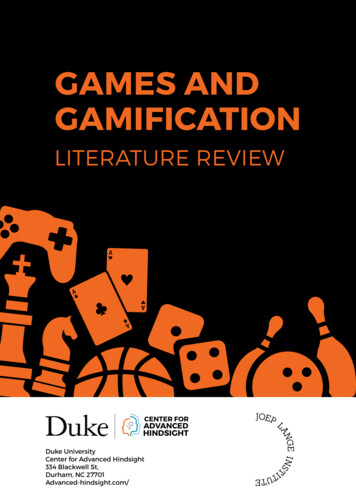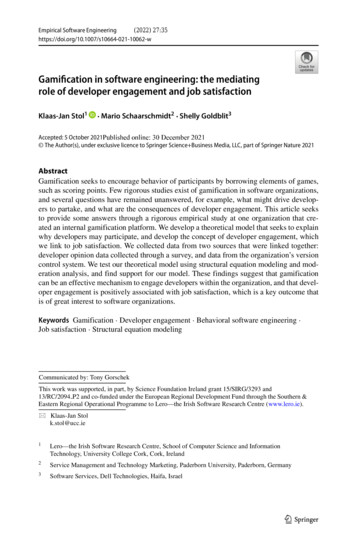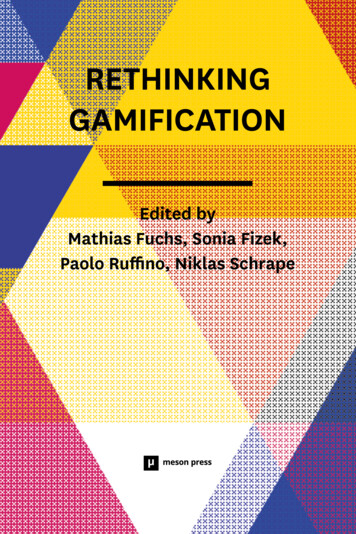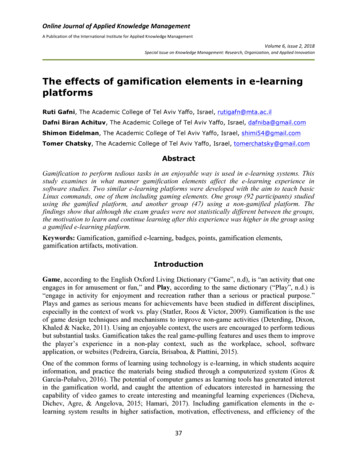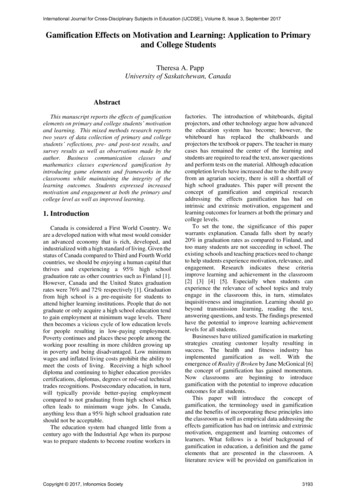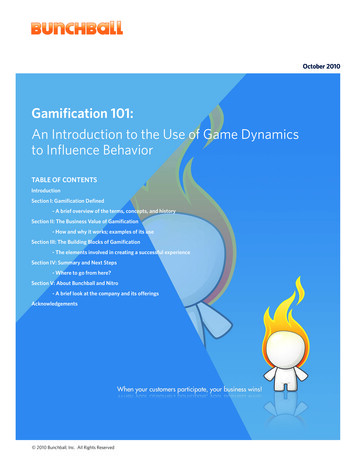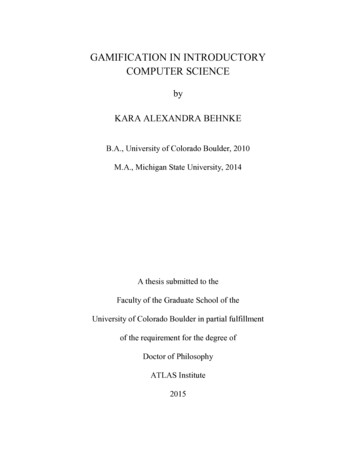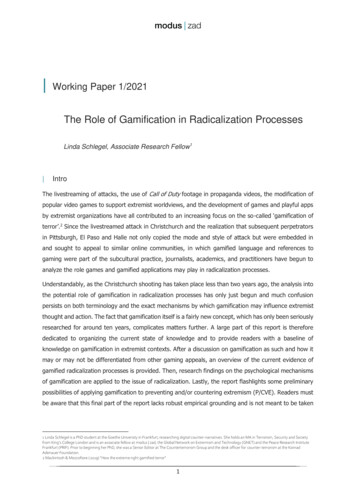
Transcription
Working Paper 1/2021The Role of Gamification in Radicalization ProcessesLinda Schlegel, Associate Research Fellow1 IntroThe livestreaming of attacks, the use of Call of Duty footage in propaganda videos, the modification ofpopular video games to support extremist worldviews, and the development of games and playful appsby extremist organizations have all contributed to an increasing focus on the so-called ‘gamification ofterror’.2 Since the livestreamed attack in Christchurch and the realization that subsequent perpetratorsin Pittsburgh, El Paso and Halle not only copied the mode and style of attack but were embedded inand sought to appeal to similar online communities, in which gamified language and references togaming were part of the subcultural practice, journalists, academics, and practitioners have begun toanalyze the role games and gamified applications may play in radicalization processes.Understandably, as the Christchurch shooting has taken place less than two years ago, the analysis intothe potential role of gamification in radicalization processes has only just begun and much confusionpersists on both terminology and the exact mechanisms by which gamification may influence extremistthought and action. The fact that gamification itself is a fairly new concept, which has only been seriouslyresearched for around ten years, complicates matters further. A large part of this report is thereforededicated to organizing the current state of knowledge and to provide readers with a baseline ofknowledge on gamification in extremist contexts. After a discussion on gamification as such and how itmay or may not be differentiated from other gaming appeals, an overview of the current evidence ofgamified radicalization processes is provided. Then, research findings on the psychological mechanismsof gamification are applied to the issue of radicalization. Lastly, the report flashlights some preliminarypossibilities of applying gamification to preventing and/or countering extremism (P/CVE). Readers mustbe aware that this final part of the report lacks robust empirical grounding and is not meant to be taken1 Linda Schlegel is a PhD student at the Goethe University in Frankfurt, researching digital counter-narratives. She holds an MA in Terrorism, Security and Societyfrom King’s College London and is an associate fellow at modus zad, the Global Network on Extremism and Technology (GNET) and the Peace Research InstituteFrankfurt (PRIF). Prior to beginning her PhD, she was a Senior Editor at The Counterterrorism Group and the desk officer for counter-terrorism at the KonradAdenauer Foundation.2 Mackintosh & Mezzofiore (2019) “How the extreme right gamified terror”1
as evidence of what should or should not be done. Rather, it is meant as an invitation to explore anddiscuss the implications of gamification for P/CVE. What is gamification?The term gamification refers to the “use of game design elements within non-game contexts”.3 It entailsthe transfer of game elements such as points, leaderboards, badges, or avatars into contexts nottraditionally regarded as spaces of play with the aim of facilitating behavioral change in users. 4 Thebehavior change encouraged by the gamified application is referred to as ‘desired action’. For example,competing against one’s friends on a fitness app to lead the scoreboard and to collect achievementbadges or trophies often encourages users to increase the number of desired actions and work out moreoften or with higher intensity to collect more points. 5 The desired action could be anything encouragedby the gamified application, from clicking on links to buying products to eating healthy, inviting friendsto play an online game or spend hours collecting points, badges and increase one’s virtual ranking.Because humans are naturally drawn to play and an increasing number of individuals engage in gamingactivities way into adulthood, gamified applications are perceived by many as appealing, engaging andfun. Gamification is, in essence, a psychological tool to increase users’ motivation to become and stayengaged.6 While the concept of gamification was originally developed in the commercial sector toincrease sales and user engagement – used, among others, by Amazon, eBay, Deloitte, Google andFacebook7 – it is now increasingly applied in non-commercial settings such as education, health, work,sustainability, the military, and the public sector. 8 While theoretically applicable to the offline world,much of the literature on gamification focuses on digitally-mediated context, in which users engage withan electronic device either throughout the whole experience or at least partially as in the case of thefitness app motivating offline workouts.To be sure, gamification is not a magic bullet that automatically increases user engagement and hasdrawn its fair share of criticism.9 Simply putting a leaderboard up and awarding some points toemployees, students or users is unlikely to be enough to facilitate sustained engagement and does notautomatically create a fun environment users like to participate in. There are plenty of expensive, welldesigned applications with amazing graphics that include all kinds of gaming elements a user mightwant, which fail to generate the users’ motivation to engage.10 Individuals differ in their preferences ofdifferent gamified elements11 and gamified elements that sparked the users’ interest may not be the3 Deterding et al (2011) “From game design elements to gamefulness”, p.14 Robson et al, (2015) “Is it all a game?”5 Hamari & Koivisto (2015) “Working out for likes”6 Sailer et al (2017) “How gamification motivates”7 Chou (2015) Actionable Gamification8 Blohm & Leimeister (2013) “Gamification”; van Roy & Zaman (2019) “Unravelling the ambivalent motivational power”; Robson et al (2016) “Game on”; Gonzalez etal (2016) “Learning healthy lifestyles”9 Fleming (2014) “Gamification: Is it game over?”; Bogost (2014) “Why gamification is bullshit”10 Chou (2015) Actionable Gamification11 Bartle (1996) “Hearts, clubs, diamonds, spades”; Marczewski (2015) “User types HEXAD”2
same as the elements that sustain the users’ engagement over time. In addition, demographic factorssuch as age partially mediate the motivational effect of gamification 12, i.e. generally, the younger theuser the easier one can create motivation with simple gamified elements. Culture and values too mayinfluence the effects of various gamified elements on a given user. 13 Notwithstanding these caveats,considering that 2.4 billion people14, 1/3 of the world’s population, play electronic games (albeit withvarying degrees of frequency and seriousness), well-designed gamified applications are likely toresonate with a large number of digitally-savvy media users.When applying gamification to radicalization processes, conceptual confusion arises. The termgamification has been used to describe a variety of phenomena, from the creation of videogames byextremist organizations, to the use of actual video game sequences in propaganda videos, theproduction of video footage with HD-helmet cameras to mimic the visual style of first-person shootergames or the alleged use of gaming to prepare for an attack, to gamified language in online forums andapps such as Patriot Peer. The prominence of gaming in extremist subcultures partially mirrors broadersocietal processes. Some argue that we live in an increasingly “gameful world” 15 even a “ludic century” 16(from the Latin ludere to play) characterized by the blending of work and play in both the private andthe public sphere and the ludification of culture as a whole. While gamification is certainly on the risein all areas of life and likely to be increasingly integrated in normal life, it makes little sense at such anearly stage of research on the gamification of radicalization to refer to everything containing even aremote reference to gaming as ‘gamification’. If we want to uncover the psychological mechanisms bywhich gamification might influence radicalization processes, we need to understand what exactly thephenomenon entails.For this report, only the application of gaming elements in non-gaming contexts, as described above,will be discussed. Actual videogames developed by extremists such as the newly released HeimatDefender: Rebellion17 are better categorized as the radicalization of gaming rather than the gamificationof radicalization. Similarly, the use of footage from games in propaganda videos, mimicking the style ofvideo games with helmet cameras18 and the modification of existing games for ideological purposes,such as Stormfronts modification of Doom 2 to enable users to ‘play’ genocide 19 or gamers re-playingtheir own version of the Christchurch massacre in The Sims20, are purposefully excluded whileacknowledging the fuzziness of the boundaries between gaming, gamification and references to gamesas part of popular culture. Similarly, while worrying in its own right, the mere presence of extremists on12 Koivisto & Hamari (2014) “Demographic differences in perceived benefits from gamification”13 Khaled (2014) “Gamification and Culture”14 Cyber Athletiks (n.d.) “How many gamers are there in the world?”15 Walz & Deterding (2014) The Gameful World16 Zimmerman (2014) “Manifesto for a ludic century”17 Schlegel (2020) “No Child’s Play”18 Scaife (2017) Social Networks as the New Frontier of Terrorism19 Ebner (2019) Radikalisierungsmaschinen20 Stevens (2019) “Twisted gamers create first-person shooter video games”3
gaming servers such as Discord21 and the utilization of such platforms to communicate is not regardedas gamification for this report. Evidence for Gamification of RadicalizationWhile video games have been part of the extremist repertoire for quite some time 22, gamification hasbeen added to the ‘toolbox’ of extremist organizations and subcultures fairly recently. Public attentionhas only turned towards gamified elements of radicalization and recruitment efforts in the last two years.Therefore, the evidence available must be regarded as limited, incomplete, and anecdotal. The evidencethat has been uncovered so far may be grouped in two broad categories, namely top-down and bottomup gamification. Top-down gamification refers to the strategic use of gamified elements by extremistorganizations to facilitate engagement with their content, whereas bottom-up gamification emergesorganically in (online) communities or small groups of individuals radicalizing together. 23Top-down stsWhatStrategicBottom-up gamificationIndividuals, small groups offriends, online communitiesuseofrankings,badges, points, leaderboardsLivestreaming,gamifiedlanguage, virtual scoreboards,personal inecontent and peers, visibility ofcommunity/subculturalmilieu,commitment, motivate users tolook cool, make sense of realityparticipate, appeal to youngvia gaming contentaudienceExamplesRankings, badges etc in forums;Attacks in Christchurch andapps such as Patriot PeerHalle; small-group WhatsAppradicalization; discussions onsocial media e.g. desire to “beathis score”2421 Ebner (2020) “Dark ops: Isis, the far-right and the gamification of terror”22 Lakomy (2019) “Let’s play a video game”; Dauber et al (2019) “Call of Duty: Jihad”23 For a full discussion see Schlegel (2020) “Jumanji extremism?”24 Evans (2019) “The El Paso shooting and the gamification of terror”4
Top-down gamificationThe beginnings of top-down gamification can be traced to the forums hosted on extremist websitessince the early 2000s. Many forums included visible measures of commitment, such as different ranksor levels users could obtain for posting comments, reputation meters awarding recognition to thoseposting ‘interesting’ content and answering peer questions, and virtual badges for reaching certainmilestones of engagement such as a certain number of comments or years as an active member.Members were also rewarded for their continuous commitment by earning the right to personalize theiravatars and signatures or by being invited into certain ‘secret’ groups only a selected elite demonstratingoutstanding commitment to the forum could access. One forum even included a ‘radicalization meter’as a visualization of one’s progress toward extremism.25 While the importance of forums may havedecreased with the rise of extremist activity on social media, gaming elements such as ranks have beentransferred into other virtual settings. Ebner reports, for instance, that the far-right ReconquistaGermanica group on Discord implemented a military-style ranking and badge system, creating a clearhierarchy and a way to overtly display status differences between users. 26 In the section on “Mechanismsof Influence” (p. 7), the motivational drivers of such status elements are explored in more detail.As mainstream social media platforms became increasingly hostile environments to extremist groupsdue to account removals, content take-down and other repressive measures, some are migrating tofringe platforms such as Gab or develop their own communication and networking tools. Potentially themost prominent example of such top-down gamification in alternative settings is the app Patriot Peer,which was planned by the Identitarian Movement (Identitäre Bewegung; IB). Ultimately, the app wasnever launched, but it nevertheless provides a useful case study illustrating that extremist organizationsare aware of the potential of gamified elements and make strategic use of gamification in thedevelopment of new ‘tools’. Patriot Peer was envisioned not a fully-fledged game, but a communicationand networking tool with gamified elements featuring prominently for its users, which would “turnresistance into a game”.27 The plan was that users would collect points by acquiring virtual connectionsto other ‘patriotic individuals’ near them – to be found with a Pokémon-Go-like “Patriot Radar”28 - ,visiting designated cultural places and uploading pictures for their network to see, taking part in protestsor visiting IB events and then compare themselves to others on a virtual leaderboard.29Bottom-up gamificationIncidences of bottom-up gamification may be grouped into three broad categories: gamification drivenby perpetrators of attacks, gamification within online communities, and gamification in radicalizationprocesses of individuals and small groups.25 Hsu (2011) “Terrorists use online games to recruit future jihadis”26 Ebner (2019) Radikalisierungsmaschinen27 Brust (2018) “ Rechtsextreme Scheinspielereien“28 Prinz (2017) “‘Patriot Peer‘ als Mischung zwischen Tinder und Pokemon Go“29 Schlegel (2020) “Jumanji extremism?”5
The gamification initiated by perpetrators of attacks is the most well-known aspect of bottom-upgamification. Norwegian right-wing perpetrator Anders Breivik was the first who allegedly gamified hisattack. He reported that he trained for his attack with Call of Duty and imagined himself as his avatar,effectively gamifying the experience for himself. 30 Gamification also became evident in his manifesto.He ‘played’ the leader of a secret underground organization, the Knights Templar, and pretended to bepart of an alternative reality.31 In 2012, a year after Breivik’s attack, the next step in the gamificationof attacks was taken by an extremist perpetrator in Toulouse, who videotaped his killings with a GoProcamera strapped to his chest and posted the footage online.32His viewers and supporters had a ‘frontrow’ seat in the violence by watching the video, gamifying not only his experience but the experienceof his viewers. The video’s setup mimicked the visual style of Let’s Play videos of popular first-personshooter games. Let’s Play videos, which allow users to observe someone else playing a video game, areextremely popular in the gaming community: In April 2018, users spend 128 million hours on Twitchwatching others play the popular game Fortnite.33 However, the viewers of the Toulouse video werewatching and engaging with the content only in retrospect, long after the events shown had takenplace. The current generation of gamifying perpetrators, from Christchurch to El Paso and Halle, isespecially well-known for livestreaming their attacks, although not every perpetrator will necessarilyattempt the livestreaming. 34 It does not get more ‘front row’ than watching a livestream of an attackmirroring the style of first-person shooter games and commenting on the perpetrator’s actions in realtime, much like a livestreamed Let’s Play video. Livestreams, therefore, gamify both the attacker’s andthe viewers’ experience of the event. 35The perpetrators, who livestreamed their attacks, were often embedded in far-right online subcultures.Bottom-up gamification has become increasingly prominent in such online communities, for instance onGab or 8chan (now 8kun). Certain parts of such digital subcultures are highly supportive of far-rightextremist violence. The Halle attacker, for instance, has been celebrated as a “saint” on far-rightTelegram channels.36 Various online communities keep virtual scoreboards that rank the ‘success’ of farright perpetrators and some users have expressed the desire to “beat his [the Christchurch attacker]score” or rated attacker’s ‘body counts’. 37 These are the communities perpetrators livestreaming theirattacks seek to appeal to with gamified language used during their livestreams and from thesecommunities stems the social recognition perpetrators ‘placing high on the scoreboard’ receive. Gamifiedlanguage might seem less important than gamified action, but it sets the stage to understand realitythrough a gaming lens and can encourage the gamification of behavior.30 Pidd (2012) “Anders Breivik 'trained' for shooting attacks by playing Call of Duty”31 Breivik (2011) “2083 – A European declaration of independence”32 Weimann (2012) “Lone wolves in cyberspace”33 Bowels (2018) “All We Want to Do Is Watch Each Other Play Video Games”34 Macklin (2019) “The Christchurch attacks: Livestream terror in the viral video age”35 Schlegel (2020) „Jumanji extremism?”36 Owen (2019) “White Nationalists on Telegram Are Hailing the Germany Synagogue Shooter as a ‘Saint’”37 Evans (2019) “The El Paso shooting and the gamification of terror”6
The last category includes instances of gamification in private chats and small groups. Here the evidencebase is the most limited. Whereas livestreaming of attacks seeks the highest degree of publicity possibleand online communities on chan-boards or Gab are often at least partially accessible to researchers foranalysis, individual and small-group gamification is the most difficult to trace. Currently, it cannot beestimated with any reasonable degree of certainty how prevalent gamification is in such privatecommunication channels. One of the few cases available - because evidence was preserved in aWhatsApp chat protocol - is the gamified radicalization of a group of young men from Rochdale (UK).38During the process of jihadist radicalization, they used gaming elements they had encountered invideogames to make sense of their own reality and gamify their own experience. For instance, theyconducted ‘raids’ against Shia individuals they perceived as ‘sorcerers’. These ‘raids’ includedsurveillance of the individuals in question, taking pictures as well as the theft of ‘black magic objects’,ultimately culminating in physical harm. Raids are a popular element in video games such as World ofWarcraft. A group of players, often belonging to the same guild, break into a dungeon together anddefeat an adversary to collect points, increase their levels, and steal valuable assets such as newweapons or body armor from the dungeon. The young men transferred this game element into reality,turning their radicalization into an extension of the video games they had played and, importantly,experienced the same social relatedness driving the action of guilds. Contrary to popular belief, theappeal of many video games is the community and social connection to others, 39 which too carried overinto the mens’ gamified perception of reality. Mechanisms of InfluenceBecause the mechanisms by which gamification operates are often discussed either in terms of whatmotivates individuals to play in general or in terms of initiating and sustaining customer engagement inthe commercial sector, not all mechanisms of influence are immediately applicable to the context ofradicalization. In addition, as already discussed, the evidence base for the gamification of radicalizationis small and may not be easily observable (e.g. in private chats and closed forums). Therefore, whilethe mechanisms detailed are grounded in gamification research, they have not been analyzed empiricallyin the context of extremism and represent a preliminary framework to understand the gamification ofradicalization. The following discussion of mechanisms of influence gamification might have onradicalization processes is based on a selective and condensed application of motivational driversgamification is believed to facilitate.40 Five mechanisms of influence are discussed below: Pleasure,positive reinforcement, empowerment, competition, and social relatedness.38 McDonald (2018) Radicalization39 Rapp (2017) “Designing interactive systems though a game lens”40 The mechanisms detailed here are derived from the following theories:Self-determination theory (Ryan & Deci, 2000; Deci & Ryan, 2000)Octalysis (Chou, 2015)Discourses of a gameful world (Deterding, 2014)7
PleasureHumans are naturally drawn to ‘play’, not only as children but way into adulthood, leading some tospeak of humans as homo ludens.41 The most obvious mechanism by which gamification leads toincreased and sustained user engagement is by making engagement more fun. Writing on the influenceof music in extremism, Pieslak writes “when attempting to draw people to radical ideology, do not leadwith the ideology if you can find a more attractive garment in which to dress the message. And musicprovides very fashionable clothes.”42 Gamification too provides very fashionable clothes for thetransmission of ideology, especially for those who have grown up with video and smartphone games.Gamified elements can lead to the perception that ‘it is just a game’, thereby normalizing extremistcontent conveyed through these applications and linking the experience of fun with the ideologicalsubstance transmitted. In addition, the perception that ‘it is just a game’ can limit psychologicalreactance; that is, the resistance displayed when persuasion attempts are very obvious. Because gamingelements are not perceived as belonging in the realm of persuasion tools and users are letting theirguard down when having fun, gamification can be a useful tool to influence users subconsciously and‘by the back door’.Positive ReinforcementIn contrast to the real world, video games often provide players with instant feedback for their actions,e.g. by failing a level or winning points for a successful move. Many gamified applications use the powerof feedback loops to nudge users’ behavior in a certain direction. 43 For instance, fitness apps displayfeedback on length and intensity of workouts as well as how the workout compares to the user’sperformance the previous week or the previous month. When behaving ‘good’, users are given positivefeedback, creating positive reinforcement and increasing the likelihood that users will continue toengage in the desired actions. Extremists may benefit from such instant feedback and positivereinforcement mechanisms. Rather than having to instruct each individual user, users know what isexpected of them and considered ‘good behavior’ by learning how to gain points, badges or level-up inthe context of a gamified application. They can monitor themselves and their own engagement withand commitment to the extremist group by reviewing how many points they gained or how many ‘quests’they fulfilled in the previous week or month. Being rewarded for continuous ‘good behavior’ is a strongmotivational incentive to continue this behavior or even increase engagement with the extremist contentdisplayed on the gamified application.EmpowermentGamification can help users feel empowered, autonomous, and competent. A key element of gaming ischoice: A game in which there is only one way to play and one strategy that will lead to victory willbecome boring very fast, whereas a game that offers multiple routes to success, affords the player a41 Huizinga (2016) Homo Ludens42 Pieslak (2017), “A musicological perspective on jihadi anashid”, p.7543 Deterding (2014) “The ambiguity of games: Histories and discourses of a gameful world”8
variety of choices and the chance to be creative within the gaming context, will be engaging for longerperiods of time. Similarly, gamified applications which offer this choice, for example by awarding pointsfor a variety of different activities and accommodating the different preferences of players, will generatemore sustained engagement as applications that do not afford such choices. Extremists could provideusers with a variety of choices for engagement, for instance by awarding points to users for postingcomments, liking pages, ‘trolling’ under an article of a mainstream news outlet, but also by visitingdesignated places, taking part in a protest or designing a flyer. The perception of personal choice,regardless of how meaningful the choices actually are, increases feelings of autonomy andempowerment as well as affording users the possibility for creative navigation of the digital world.Feeling competent, in control and self-confident in the meaningfulness of one’s actions have beendiscussed as facilitators of need-driven radicalization processes.44 Gamification may afford users suchexperiences. Users may feel empowered not only by choice but by the perception that their owncompetency increases. When overcoming a challenge, successfully mastering a task and being rewardedfor it by points, level-ups or badges, dopamine is released in the brain leading users to feel good aboutthemselves and their skills.45 Completing a gamified task increases self-confidence and often leads toseeking another dopamine rush, i.e. continuing to engage with the gamified application to collect morepoints and feel accomplished. Because users feel good about themselves, engagement with theapplication and therefore with the extremist content displayed, increases. Ultimately, this feeling ofcompetency may spill over to the real world. Individuals in the process of radicalization need to possessa certain degree of self-efficacy; that is, the believe that they are capable to be successful within anextremist context and that they (as opposed to someone else) have an important role to play.46 Leadingthe scoreboard and being successful in the digital world may increase perceptions of self-efficacyregarding one’s ‘calling’ as an extremist actor and could accelerate radicalization processes.CompetitionUsers of gamified applications differ in the degree of competitiveness they exhibit. Individuals scoringhigh on competitiveness enjoy collecting points, increasing their ranking, and comparing themselves toothers on a virtual leaderboard. They are motivated to improve their position relative to others and ‘win’against their peers. For these users, publicly visible badges, a high number of points collected, and aprominent position on the scoreboard provide a sense of accomplishment. Psychological well-being isincreased, because users feel competent and are proud not only of mastering the challenges thegamified application presenting themselves with but of their relative accomplishments in comparison totheir peers. Gamified elements such as points, badges, rankings and leaderboards provide visible,quantifiable and clear goals to users; i.e. they know exactly what they need to do and how many pointsthey need to collect in order to improve their position on the scoreboard. In other words, gamification44 Möller et al (2016). "Die kann ich nicht ab!"45 Zicherman, G. (2014) “The Future of Creativity and Innovation is Gamification”46 Schlegel (2019) “Yes I can”9
provides visible measures of engagement and ‘success’. Users may begin to collect coins by harmless,low threshold actions such as connecting to other users or liking a Facebook page, but as a competitivemotivation sets in, users may be willing to take more meaningful action to collect more points, whichmay draw them deeper into an extremist group. Competition may lead certain users to engage morethoroughly with extremist content on gamified applications and to take ‘desired actions’ when asked todo so in an effort to ‘win’ against other users.An additional mechanism by which gamification can increase a user’s engagement with extremistcontent and groups is by affording a route to increase one’s social status within the group. Leading orplacing high on the scoreboard may provide prestige within the group and affords status-seekingindividuals47 the opportunity to gain recognition. Virtual points may not mean anything in the real world,but other users of the gamified application are well aware how much effort and commitment needs tobe displayed to collect a large amount of points. Gamification elements such as scoreboards providevisible and quantifiable indicators of commitment and, therefore, of social status. Competitive users mayrise in the informal hierarchy of the group and increase their relative social position by intensecommitment to the gamified application and its contents.Social RelatednessIn contrast to highly competitive users, there are users who are not driven by seeking friendly rivalrybut by the wish for cooperation, shared goals, and social connectedness. Research has shown that socialinteraction and cooperation are key drivers of successful games with a large and loyal user base suchas World of Warcra
the potential role of gamification in radicalization processes has only just begun and much confusion persists on both terminology and the exact mechanisms by which gamification may influence extremist thought and action. The fact that gamification itse
